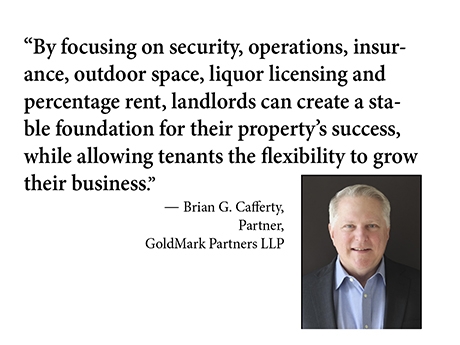By Brian G. Cafferty, partner at GoldMark Partners LLP
A popular restaurant can be a significant draw to a shopping center. However, according to a study published by Ohio State University, approximately 60 percent of restaurants fail in their first year, and 80 percent fail before the end of their fifth year. These statistics underscore the importance of landlords being protected in the likely event of a restaurant tenant’s failure.
A well-crafted restaurant lease should address the following key items to minimize a landlord’s liability:
Secure More Than Just Rent
To protect the landlord’s investment and minimize potential losses, the landlord should secure a security deposit of at least two months rent. Additionally, the tenant should grant the landlord a security interest in all of the tenant’s accounts receivables, equipment (including machinery, furniture and trade fixtures) and inventory under the Uniform Commercial Code (UCC).

Keeping the Kitchen (and Lease) Running Clean
The lease should require the tenant to contract with a third party for essential maintenance tasks, including grease removal, pest control and regular vent and hood cleaning. The frequency of the hood cleaning will depend on the type of restaurant, but quarterly cleaning is a good rule of thumb.
Landlords should require tenants to provide evidence of these contracts and submit regular reports to ensure compliance. Deliveries should also be limited to times when the tenant’s employees are onsite and available to receive them and immediately store them. Doing so avoids having the tenant’s goods sit on the sidewalk or in the loading area.
Insurance: Covering All Bases from Kitchen to Curb
Insurance is a critical concern for both landlords and restaurant tenants. Michael McShane, senior vice president of Boston-based Cleary Insurance, advises that restaurants maintain liability coverage of $1 million per occurrence and $2 million in the aggregate, with $5 million in umbrella coverage. He emphasizes the importance of ensuring that liability coverage includes assault and battery coverage, which is often excluded. McShane also stresses the need for liquor liability coverage of at least $5 million.
Take It Outside: Maximizing Outdoor Dining Without the Noise
In the wake of COVID-19, outdoor dining has dramatically increased. While outdoor dining expands the restaurant’s footprint and provides a seasonal revenue boost, landlords should be mindful of two key considerations: permits and noise.
Tenants should be required to comply with all government regulations, including noise and lighting rules, and to secure all permits before using any outdoor space. In densely populated residential areas, landlords may want to limit the hours of outdoor seating to mitigate disturbances.
Additionally, landlords should ensure that any outdoor sales are reflected in percentage rent calculations. In some cases, tenants have omitted such sales from percentage rent reporting when they occur on public sidewalks or parking spaces, as they do not technically occur on the landlord’s property. Both the landlord and tenant should also consult with their insurance agents to ensure that the tenant’s insurance covers incidents that occur outside the premises.
Pouring Profits: Liquor License Is a Landlord’s Ace
A restaurant’s liquor license is an extremely valuable asset, critical to its operation and success. However, UCC stipulations and other landlord protections cannot be used to secure a liquor license.
Instead, the lease should stipulate that a tenant must sell the liquor license to the landlord for a moderate sum at the end of the lease term or upon termination of the lease. This provision allows the landlord to secure one of the tenant’s most valuable assets, which can help attract a new restaurant tenant to the space if the original tenant fails.
Sharing Success: Making Percentage Rent a Win-Win
Rental rate structures for restaurants often include a relatively low base rent with provisions for percentage rent. In exchange for a low minimum/base rent, the landlord can collect additional rent if the restaurant is successful.
With percentage rent, the tenant pays additional rent (generally quarterly) if the tenant’s gross sales exceed a certain threshold. The landlord would then receive a fixed percentage of the gross sales above this floor. This structure relieves the financial pressures on the restaurant while allowing the landlord to share in its financial success.
The definition of gross sales in the lease is crucial to calculating the amount owed to the landlord. Should gross sales be defined by revenue earned, allowing the tenant to deduct taxes and financing fees? Should it include take-out sales, deliveries, catering, lottery sales or proceeds from the sale of gift certificates? If so, should the amount of the gift certificate be counted when sold or redeemed? Should gross sales include any cover charge if entertainment is provided? There are many ways to calculate and define gross sales, and what is included or excluded may affect where the landlord and tenant set the floor for collecting percentage rent.
A Recipe for Success: Building a Lease That Benefits All
A comprehensive restaurant lease that addresses these essential matters provides a balanced agreement, safeguarding both landlord and tenant interests. By focusing on security, operations, insurance, outdoor space, liquor licensing and percentage rent, landlords can create a stable foundation for their property’s success, while allowing tenants the flexibility to grow their business.
The ultimate goal should be a partnership that encourages the restaurant’s success, as this in turn benefits the entire shopping center. A well-crafted and executed lease can turn a potentially risky venture into a mutually beneficial long-term relationship.
About the Author
Brian G. Cafferty is a partner at GoldMark Partners LLP, a boutique law firm based in Needham, Massachusetts, that focuses on commercial real estate and corporate law. His background encompasses real estate, corporate governance, and finance, acquisitions, zoning, commercial leasing and environmental compliance. He is also experienced with Chapter 91 filled tidelands and Chapter 21E hazardous waste sites. Brian can be reached at bcafferty@goldmarkllp.com.


